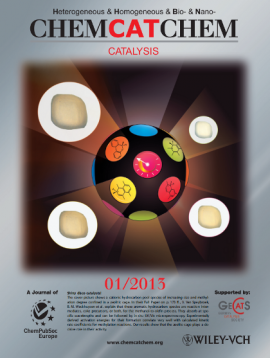Identification of intermediates in zeolite-catalyzed reactions using in-situ UV/Vis micro-spectroscopy and a complementary set of molecular simulations
Abstract
The optical absorption properties of (poly)aromatic hydrocarbons occluded in a nanoporous environment were investigated by theoretical and experimental methods. The carbonaceous species are an essential part of a working catalyst for the methanol-to-olefins (MTO) process. In situ UV/Vis microscopy measurements on methanol conversion over the acidic solid catalysts H-SAPO-34 and H-SSZ-13 revealed the growth of various broad absorption bands around 400, 480, and 580 nm. The cationic nature of the involved species was determined by interaction of ammonia with the methanol-treated samples. To determine which organic species contribute to the various bands, a systematic series of aromatics was analyzed by means of time-dependent density functional theory (TDDFT) calculations. Static gas-phase simulations revealed the influence of structurally different hydrocarbons on the absorption spectra, whereas the influence of the zeolitic framework was examined by using supramolecular models within a quantum mechanics/molecular mechanics framework. To fully understand the origin of the main absorption peaks, a molecular dynamics (MD) study on the organic species trapped in the inorganic host was essential. During such simulation the flexibility is fully taken into account and the effect on the UV/Vis spectra is determined by performing TDDFT calculations on various snapshots of the MD run. This procedure allows an energy absorption scale to be provided and the various absorption bands determined from in situ UV/Vis spectra to be assigned to structurally different species.

